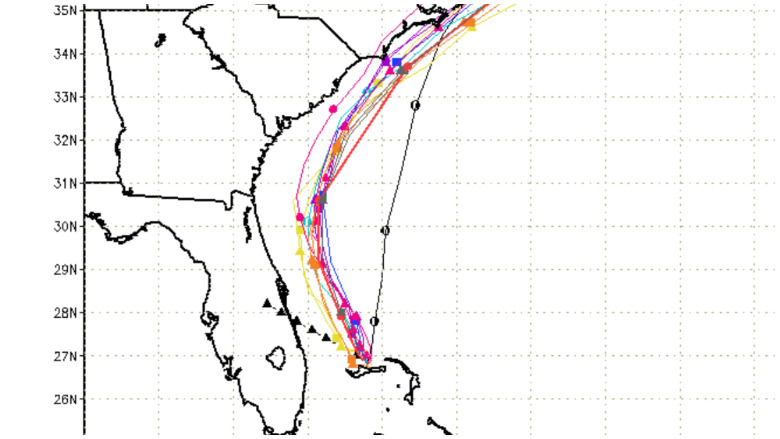
This is 30 knots higher in wind speed and almost 10 feet larger in wave height than predicted by the 7-Day Wind and Wave Forecast. As you can see, the Hurricane Model is predicting wind gusts as high as 99 knots and wave heights reaching 45 feet.

Now, compare this forecast with the Hurricane Model forecast (second image below) for the exact same location. In the 7-Day Wind and Wave Forecast (first image below), it's evident that the most extreme conditions will occur at this location around Saturday at 2:00PM with wind gusts as high as 69 knots and peak waves reaching 36 feet. Let's take a look and compare the Hurricane Model output with the 7-Day Wind and Wave Forecast output for a point located just offshore of Cape Hatteras - an area forecast to be hit directly by Hurricane Irene. The Hurricane Tracking Tool (above) can be found under the 'Tropical Storm Links' drop down menu on the left side of any 7-day forecast page, as shown below. See the official forecast track from the National Hurricane Center displayed on the Buoyweather Hurricane and Typhoon Tracking System below. Category 3 Hurricane Irene is currently set to sweep up the Eastern Seaboard over the next several days. Now, let's apply this knowledge in a real-time environment. Outside this AOI, the GFS takes over where it is found to be more accurate. In the Hurricane Model, the area over the ocean that is encompassed by a hurricane, otherwise known as the Area of Influence (AOI), uses winds from the GFDL model. The GFDL has a higher spatial resolution than the GFS, and thus can better capture the extreme wind speeds in the eye of a hurricane. Note - the higher the spatial resolution, the better chance a model has at resolving small-scale weather features. In short, the GFS suffers from a spatial resolution that is too coarse to properly capture these extreme winds.

These wind speeds are typically found tightly packed near the eye of the storm and, in most cases, only cover a relatively small area. One issue with the GFS is that it struggles to realistically simulate the strongest wind speeds found in the eye of a hurricane. On the other hand, the 7-Day Wind and Wave Forecast product only uses the GFS winds to drive the wave model. The Buoyweather Hurricane Model uses a blended combination of two wind models, the Global Forecast System (GFS) and the Geophysical Fluid Dynamics Laboratory (GFDL), to force the wave model. Now to the models - The most significant difference between the Hurricane Model and the 7-Day Wind and Wave Forecast product lies in the winds used to force the NOAA WAVEWATCH III wave model. Now, in order to get an accurate wave forecast, in theory, you need an accurate wind forecast. Thus, wave models need to be provided with a field of wind speeds and directions so that the wave model can do its work and yield a wave forecast. Lets start with the basics - In order to get waves, you need wind.

The location of the Hurricane Model forecast, indicated by the arrow under the 'Location Forecasts' drop down menu.
HURRICANE TRACK MODELS MOST ACCURATE TRIAL
If you are not already a member, START A FREE TRIAL to gain access today!

NOTE The Buoyweather Hurricane Model is a Premium only tool. This tutorial is meant to describe the difference between the Hurricane Model and the 7 day Wind and Wave Forecast, as well as what makes the Hurricane Model unique in these situations. The Hurricane Model can be found under the 'Location Forecasts' drop down menu on the left side of any 7-day forecast page, as shown below. In other words, the Hurricane Model supplements the Buoyweather 7-day Wind and Wave Forecast under extreme hurricane conditions. The Buoyweather Hurricane Model is a product used to provide further weather guidance when hurricanes exist.


 0 kommentar(er)
0 kommentar(er)
